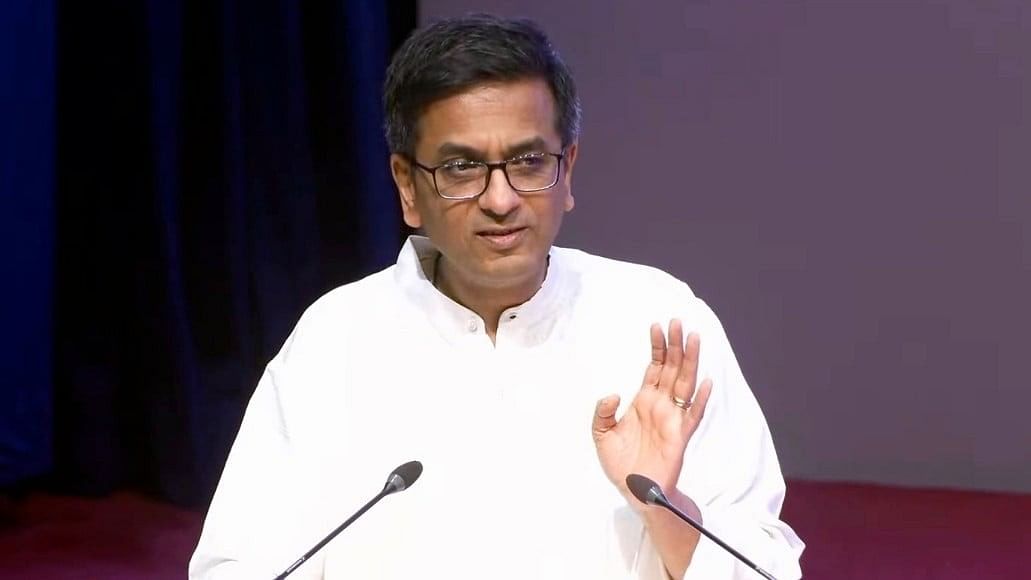
Justice D Y Chandrachud
Credit: PTI Photo
Justice D Y Chandrachud has garnered admiration for his progressive judgements on environmental issues, contributing significantly to India’s environmental jurisprudence. However, these strides often fall short of the actionable plans required to address the climate crisis comprehensively.
Justice Chandrachud has repeatedly emphasised the need for robust environmental governance. In recent speeches, he has asserted that climate change cannot be ignored. He has even adopted a vegan lifestyle.
As a former intern with Justice Chandrachud, I saw his deep love for nonhuman life forms firsthand. The gardens of 5 and 7 Krishna Menon Marg, his former residence and office, are home to many peacocks, all of whom are well cared for by the Chandrachud family.
In my brief interaction with him, he expressed his fondness for animals. I remember a moment from my internship when one of the family cats briefly went missing. Justice Chandrachud shared his anxiety with me when he received the news while in court.
He also mentioned that some peacocks and peahens had followed his family from their previous home to their current residence, showcasing his affection for animals. These personal interactions revealed a compassionate individual who values all living beings. However, this compassion didn’t always translate into actions in the cases before him.
Justice Chandrachud was the first judge to directly engage with the concept of Environmental Rule of Law (EROL) in India. In Hanuman Laxman Aroskar vs Union of India (Mopa 1 judgement), the Supreme Court suspended the approval of a project for a second airport in the Mopa Plateau, an ecologically sensitive area, citing the need for a rigorous Environmental Impact Assessment (EIA).
The State had misled authorities regarding the ecological sensitivity of the Mopa plateau. The court’s strong stance was hailed both nationally and internationally, marking a significant advancement in Indian environmental law.
Justice Chandrachud asserted that “We cannot gamble with the environment; a ‘heads I win, tails you lose’ mentality is completely unacceptable if we are to uphold environmental governance under the rule of law.”
However, this progress was diluted by the subsequent Mopa 2 judgement (January 2020), where the same bench lifted the suspension on the project, relying on the Expert Appraisal Committee’s report despite the absence of a detailed avi-faunal study mandated earlier.
This ruling framed the issue as a trade-off between development and environmental protection, suggesting a false dichotomy between economic growth and ecological preservation. This reflects a troubling trend where economic considerations often overshadow environmental imperatives.
In Bangalore Development Authority vs Mr Sudhakar Hegde & Ors, Justice Chandrachud engaged with EROL at length again. Speaking on behalf of the Court, Justice Chandrachud held that “in matters of environment and development, there is no trade-off between the two because the protection of the environment is an inherent component of development”.
This was also echoed in Himachal Pradesh Bus-Stand Management & Development Authority vs The Central Empowered Committee Etc. & Ors, wherein Justice Chandrachud highlighted that the lack of quantifiable harm in environmental cases should not prevent courts from acting on violations. While these rulings advanced the legal understanding of environmental governance, they too were followed by setbacks.
The recent judgement in M K Ranjitsinh & Ors vs Union of India & Ors holds significance as the first instance where the Supreme Court recognised the right against adverse effects of climate change.
The Court’s jurisdiction was invoked for protecting the Great Indian Bustard and the Lesser Florican, with both species being on the brink of extinction.
Yet, the judgement ultimately missed the mark by adopting an anthropocentric view at the expense of broader ecological concerns. It simplifies the complex energy transition process, suggesting a straightforward shift from fossil fuels to renewable energy without addressing the underlying implications, such as ecological degradation, habitat fragmentation, and the threat to the Great Indian Bustard population due to overhead power lines. A right against climate change requires a thorough understanding of our duties. Without delineating our duties towards mitigating climate change, recognising a right against its adverse effects renders that right meaningless.
Further, this judgement reflects a broader trend in some of Justice Chandrachud’s rulings, where the language often drifts into platitudes—vague declarations with little to no actionable plans. Without a robust legal framework that imposes real consequences for inaction or grave infractions, the executive may lack the necessary impetus to treat climate change as an existential threat. Our courts must move beyond rights-based judicial pronouncements and adjudicate on affirmative obligations for the executive.
The climate crisis is not just a legal issue but a moral one, demanding a holistic approach that integrates ecological integrity into every judicial decision. These decisions help guide public discourse and create broad substantive protections for the environment, accompanied by an increased likelihood of compliance with environmental laws.
It is vital that the judiciary build on Justice Chandrachud’s judgements in environmental jurisprudence, embracing a philosophy that prioritises accountability and offers solutions to the climate crisis, but it will require a departure from platitudes to action—a commitment not just to words but to tangible, impactful change.
(The writer is a Research Fellow at Vidhi Centre for Legal Policy, New Delhi)